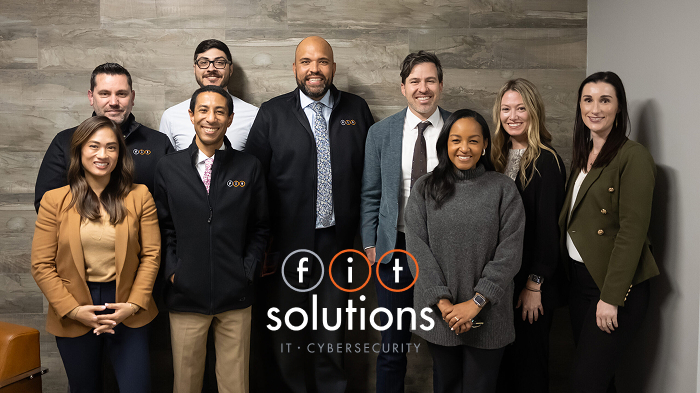Today’s businesses face growing cyber risks and cyber threats, making it critical to protect operations and data. A Virtual CISO (Chief Information Security Officer) provides a strategic solution, delivering cybersecurity expertise without the cost of a full-time executive. This flexible role enhances an organization’s cybersecurity posture, offering robust defense against the evolving challenges of the cybersecurity industry. For many organizations grappling with unique challenges, a Virtual CISO provides tailored strategic guidance to align security with business objectives and ensure regulatory compliance.
Fit Solutions, a trusted vCISO provider, empowers businesses with comprehensive virtual CISO services. Drawing on extensive industry experience, Fit Solutions helps organizations navigate complex security needs, from meeting standards like GDPR to safeguarding critical assets.
This article explores the transformative value of a Virtual Chief Information Security Officer, outlining its benefits, approaches, and why it’s an ideal choice for businesses seeking cost-effective, expert-led cybersecurity. Whether you’re a small business or a large enterprise, learn how Fit Solutions can strengthen your security strategy to succeed in an increasingly connected world.
Table of Contents
- Discover the Power of a Virtual CISO Solution
- What Does a Virtual CISO do?
- Why Hire a vCISO
- 8 Common Benefits of Hiring a Virtual CISO
- What is the Difference Between VCIO and vCISO?
- What if I Can’t Hire a Full-Time CISO?
- What Are the Signs Your Business Needs a Virtual CISO (vCISO)?
- Signs a vCISO Service is Right for Your Business
- 3 Common Virtual CISO Approaches
- Conclusion
Discover the Power of a Virtual CISO Solution

A Virtual CISO delivers expert guidance to strengthen an organization’s overall security posture, addressing cybersecurity needs with precision and agility. Unlike a traditional CISO, a Virtual CISO provides strategic oversight and hands-on support without the commitment of a full-time executive. This flexibility makes vCISO services ideal for organizations seeking expert guidance, allowing businesses to access top-tier cybersecurity expertise tailored to their unique challenges. Whether it’s a small business or a growing enterprise, a Virtual CISO adapts to varying needs, ensuring robust protection against evolving threats.
Fit Solutions excels in crafting cybersecurity strategies and developing security frameworks that align with each client’s goals. Our tailored approach assesses vulnerabilities, prioritizes risks, and builds resilient defenses, empowering businesses to operate confidently.
The cost efficiency of vCISO services stands out, offering high-level expertise at a fraction of the cost of a full-time CISO. This scalability ensures organizations can adjust services as cybersecurity needs evolve, from periodic consulting to comprehensive program management. Fit Solutions’ vCISO services provide a powerful solution, blending strategic insight with practical implementation to safeguard critical assets.
Work with Our
24/7/365 Cyber Team
What does a virtual CISO do?

A Virtual CISO plays a pivotal role in fortifying an organization’s cybersecurity by blending strategic vision with tactical execution. Their core responsibilities include conducting comprehensive risk assessments to identify vulnerabilities and threats, ensuring a clear understanding of the organization’s security posture. They implement security policies tailored to mitigate risks while fostering a culture of compliance management to meet industry regulations such as GDPR or HIPAA. Incident response is another critical function, where a Virtual CISO develops and oversees plans to swiftly address and recover from security breaches, minimizing damage to critical assets.
Strategically, a Virtual CISO aligns the security strategy with business goals, ensuring cybersecurity supports organizational growth and innovation. This involves prioritizing investments in security measures that protect critical assets while enabling operational efficiency.
On the tactical side, they focus on vulnerability management, proactively addressing weaknesses in systems and networks. Developing policies that are practical and enforceable is key, as is training technical teams to maintain robust defenses and respond effectively to threats.
Fit Solutions leverages our technical expertise to deliver cybersecurity program leadership, guiding organizations through complex security challenges. For example, a Virtual CISO might ensure compliance with HIPAA by assessing a healthcare provider’s data handling processes, implementing encryption policies, and training staff on secure practices. This comprehensive approach not only meets regulatory requirements but also builds resilience against cyber threats. By combining strategic oversight with hands-on implementation, a Virtual CISO drives measurable improvements in security, empowering organizations to operate confidently in an ever-evolving threat landscape.
Why hire a vCISO?

As cyber threats grow in frequency and sophistication, businesses face increasing pressure to protect their operations and data. The complexity of these threats demands cybersecurity professionals with specialized expertise, but not every organization can support a full-time, in-house CISO. A vCISO, or fractional CISO, offers a compelling alternative, delivering high-level security leadership without the expense of a full-time employee. This cost efficiency allows businesses to access top-tier guidance while managing budgets effectively, making vCISO services a practical choice for many organizations.
Beyond financial benefits, a vCISO brings an external perspective that is invaluable for making informed decisions about security measures. Unlike internal staff who may be entrenched in day-to-day operations, a vCISO provides an objective view, identifying blind spots and recommending strategies to strengthen defenses. This fresh insight ensures that cybersecurity aligns with evolving threats and organizational priorities, reducing vulnerabilities and enhancing resilience.
Fit Solutions stands out as a leader in vCISO services, offering tailored expertise to help organizations navigate the complexities of modern cybersecurity. Our approach empowers businesses to stay ahead of cyber threats without overextending resources.
To fully appreciate the value of a vCISO, it’s worth exploring the specific benefits they bring, from cost savings to strategic alignment, which can transform an organization’s security posture.
Work with Our
24/7/365 Cyber Team
8 Common Benefits of Hiring a Virtual CISO

Hiring a Virtual CISO offers a range of advantages that empower organizations to strengthen their cybersecurity without the overhead of a full-time executive. Here are eight key benefits that highlight the value of this approach:
Cost Efficiency
A Virtual CISO provides expert leadership at a fraction of the cost of a full-time CISO, making high-level cybersecurity accessible for businesses with limited budgets.
Access to Cybersecurity Expertise
Virtual CISOs bring broad range experience, with security leaders who have navigated diverse threats across industries, ensuring top-tier guidance.
Scalability
Virtual CISO services adapt to evolving security needs, supporting organizations as they grow and their cybersecurity maturity develops, from startups to enterprises.
Enhanced Regulatory Compliance
A Virtual CISO ensures adherence to standards like PCI-DSS or SOC 2, helping businesses meet regulatory compliance requirements and avoid costly penalties.
Improved Risk Management
Through comprehensive risk assessments and security program development, Virtual CISOs identify vulnerabilities and implement strategies to mitigate risks effectively.
Faster Incident Response
With tailored plans, a Virtual CISO accelerates incident response, minimizing damage to information assets and maintaining operational continuity.
Boosted Cybersecurity Efforts
Virtual CISOs provide training to enhance employee awareness, strengthening cybersecurity efforts across the organization and reducing human error risks.
Alignment with Business Objectives
By aligning cybersecurity goals with business objectives, Virtual CISOs ensure security supports growth, innovation, and customer trust.
What is the difference between VCIO and vCISO?

A Virtual Chief Information Officer (VCIO) and a Virtual Chief Information Security Officer (vCISO) serve distinct yet complementary roles in executive management. A VCIO focuses on information technology strategy and operations, guiding organizations in optimizing IT infrastructure, adopting new technologies, and aligning IT with business goals. Their work centers on enhancing efficiency, streamlining processes, and driving digital transformation across the organization’s technology landscape.
In contrast, a vCISO is dedicated to information security, prioritizing security policies, cybersecurity risk management, and the protection of critical assets. The vCISO develops and enforces strategies to safeguard data, ensure compliance with regulations, and mitigate threats, focusing specifically on building a resilient security posture. While a VCIO might oversee broad IT initiatives, a vCISO hones in on defending against cyber threats and maintaining robust security frameworks.
There can be overlap in executive management, as both roles provide strategic leadership and advise on technology-related decisions. A VCIO may touch on security as part of IT governance, while a vCISO might influence IT priorities to enhance security. Businesses need a VCIO for IT optimization and a vCISO when cybersecurity risks demand specialized attention. Misconceptions in other organizations often blur these roles, with some assuming a virtual CISO vCISO handles all IT functions, which can lead to gaps in either security or operational strategy.
Fit Solutions addresses this by offering integrated vCISO and VCIO services, tailoring solutions to cover both cybersecurity and IT needs. This holistic approach ensures organizations benefit from comprehensive leadership, clarifying roles and maximizing efficiency without overlap or confusion.
Your Dedicated IT & Cybersecurity Team
What if I Can’t Hire a Full-Time CISO?

Hiring a full-time CISO presents significant challenges for many organizations. The high costs of a six-figure salary, combined with benefits and overhead, can strain budgets, especially for small and medium-sized businesses (SMBs). Talent shortages further complicate the issue, as the demand for experienced cybersecurity leaders outpaces supply, making it difficult to find qualified candidates. Resource constraints also limit the ability of enterprises to dedicate personnel to strategic security roles, increasing business risk in an era of escalating cyber threats.
Virtual CISO services offer a practical solution, delivering expert cybersecurity leadership without the expense of a full-time hire. A Virtual CISO provides SMBs and enterprises with access to seasoned professionals who mitigate business risk by developing tailored security strategies. This approach is both cost-effective and flexible, allowing organizations to address critical security needs without overextending resources.
Fit Solutions excels in providing vCISO services that offer strategic guidance and an outside perspective. Our experts assess vulnerabilities, align security with business goals, and bring fresh insights to strengthen defenses. For example, a mid-sized healthcare provider facing HIPAA regulatory requirements might engage a Virtual CISO to implement compliant data protection measures, avoiding penalties while enhancing security. This demonstrates the power of vCISO services to deliver results efficiently.
To determine if this approach is right for your organization, it’s important to recognize the signs that indicate a need for a Virtual CISO’s expertise.
What Are the Signs Your Business Needs a Virtual CISO (vCISO)?

Businesses often overlook cybersecurity until a crisis exposes vulnerabilities, but certain signs indicate the need for a Virtual CISO (vCISO) to strengthen defenses. One clear signal is the absence of a security strategy or a formal cybersecurity program, leaving organizations ill-equipped to handle evolving threats. Without a structured approach, businesses risk inconsistent protections and reactive measures that fail to safeguard critical assets.
Frequent cybersecurity incidents, such as data breaches or system vulnerabilities, are another red flag. These events not only expose critical assets but also erode customer trust and incur financial losses. Similarly, regulatory compliance requirements, like HIPAA or GDPR, demand specialized knowledge to avoid penalties and ensure adherence, a challenge for organizations lacking in-house expertise.
A shortage of cybersecurity expertise or dedicated security leaders is a common issue, particularly for small to medium-sized businesses. Without skilled professionals, it’s difficult to implement effective security measures or maintain a robust cybersecurity posture. Rapid business growth can exacerbate these problems, as expanding operations often outpace existing security measures, creating gaps that attackers can exploit.
Fit Solutions addresses these challenges by assessing an organization’s cybersecurity needs and delivering tailored vCISO services. Our experts evaluate vulnerabilities, compliance obligations, and growth-related risks to design a cybersecurity program that aligns with business goals. For instance, a fast-growing e-commerce company might rely on Fit Solutions to develop a GDPR-compliant security strategy, ensuring customer data protection while supporting expansion.
Work with Our
24/7/365 Cyber Team
Signs a vCISO service is right for your business

Determining whether a vCISO service suits your organization involves recognizing specific operational and strategic needs. Budget constraints often make hiring a full-time CISO impractical, as the high salary and associated costs can strain financial resources. A vCISO service offers a cost-effective alternative, providing expert guidance without the overhead of a permanent executive, making it ideal for businesses with limited funds.
Another sign is the need for a fractional CISO to address project-based or periodic security needs. For instance, a company launching a new product or undergoing a compliance audit may require temporary, specialized support rather than a long-term hire. A vCISO service delivers targeted expertise for these scenarios, ensuring security needs are met efficiently.
The desire for an external perspective also signals the value of a vCISO. Internal teams may overlook vulnerabilities due to familiarity, whereas a vCISO brings fresh insights to enhance cybersecurity strategies, identifying gaps and recommending innovative solutions. Additionally, growing business risk—driven by expanding operations or increasing cyber threats—demands expert guidance to navigate complex challenges effectively.
Fit Solutions offers customized virtual CISO services tailored to address unique challenges. Our approach involves assessing a company’s specific risks and goals to craft strategies that align with business priorities, such as securing a new cloud infrastructure or meeting industry standards. By opting for a vCISO service, organizations gain the flexibility and expertise needed to bolster security without overextending resources, making it a strategic choice for managing today’s evolving threats.
3 Common Virtual CISO Approaches

A Virtual CISO can engage with organizations through three primary approaches, each tailored to specific cybersecurity needs: advisory, implementation, and hybrid.

The Advisory Approach
The advisory approach focuses on consulting, guiding businesses on developing a security framework, conducting risk assessments, and crafting security policies. This is ideal for organizations with internal teams capable of execution but needing strategic direction. Pros include cost-effectiveness and high-level expertise, but it may lack hands-on support, which can be a drawback for resource-constrained firms.

The Implementation Approach
The implementation approach involves hands-on execution of a security program, including vulnerability management and operationalizing security measures. This suits businesses or government agencies requiring immediate, tactical support to address urgent threats. The benefit is rapid deployment of defenses, though it may come at a higher cost and rely less on long-term strategy, potentially limiting scalability.

The Hybrid Approach
The hybrid approach blends advisory and implementation, offering comprehensive risk assessments alongside practical execution. It’s versatile, addressing both strategic and operational needs, making it suitable for complex environments like government agencies or private businesses with evolving cybersecurity goals. While comprehensive, it may require more coordination to balance priorities.
For example, a mid-sized financial firm could partner with Fit Solutions using a hybrid Virtual CISO approach to improve cybersecurity maturity. The vCISO could conduct risk assessments to identify gaps, develop tailored security policies, and implement a vulnerability management program. This dual focus would strengthen the firm’s defenses and ensure compliance with industry standards, demonstrating measurable progress.
Fit Solutions’ flexible vCISO provider model adapts these approaches to meet specific cybersecurity goals, whether for government agencies needing regulatory alignment or private businesses seeking robust protection. Our tailored solutions ensure organizations achieve a mature, resilient security posture, regardless of the approach chosen.
Take Your IT to the Next Level with FIT Solutions.
Conclusion

A Virtual CISO is a transformative solution for organizations aiming to strengthen their cybersecurity posture while aligning with business goals. By delivering expert guidance, Virtual CISOs address complex threats, ensure regulatory compliance, and build resilient defenses tailored to unique cybersecurity needs. This approach offers flexibility, cost efficiency, and strategic insight, making it an invaluable asset in the ever-evolving cybersecurity industry.
Fit Solutions stands out with its cybersecurity expertise, offering tailored vCISO services that empower businesses to navigate challenges with confidence. Our customized strategies enhance security, protect critical assets, and support growth, all while meeting stringent compliance requirements.
Whether you’re a small business or a large enterprise, Fit Solutions provides the leadership needed to thrive in a threat-filled environment.
Don’t leave your organization vulnerable. Contact Fit Solutions today to explore how our vCISO services can address your cybersecurity needs and ensure regulatory compliance. With our expert guidance, you can build a robust security framework that safeguards your business and drives success.



























